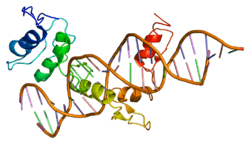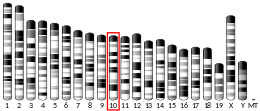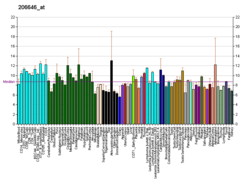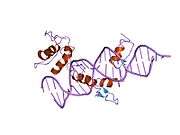GLI1
Zinc finger protein GLI1 also known as glioma-associated oncogene is a protein that in humans is encoded by the GLI1 gene. It was originally isolated from human glioblastoma cells.[5]
Function
The Gli proteins are the effectors of Hedgehog (Hh) signaling and have been shown to be involved in cell fate determination, proliferation and patterning in many cell types and most organs during embryo development.[6] In the developing spinal cord the target genes of Gli proteins, that are themselves transcription factors, are arranged into a complex gene regulatory network that translates the extracellular concentration gradient of Sonic hedgehog into different cell fates along the dorsoventral axis.[7]
The Gli transcription factors activate/inhibit transcription by binding to Gli responsive genes and by interacting with the transcription complex. The Gli transcription factors have DNA binding zinc finger domains which bind to consensus sequences on their target genes to initiate or suppress transcription.[8] Yoon[9] showed that mutating the Gli zinc finger domain inhibited the proteins effect proving its role as a transcription factor. Gli proteins have an 18-amino acid region highly similar to the α-helical herpes simplex viral protein 16 activation domain. This domain contains a consensus recognition element for the human TFIID TATA box-binding protein associated factor TAFII31.[9] Other proteins such as Missing in Metastasis (MIM/BEG4) have been shown to potentiate the effects of the Gli transcription factors on target gene transcription. Gli and MIM have been shown to act synergistically to induce epidermal growth and MIM + Gli1 overexpressing grafts show similar growth patterns to Shh grafts.[10]
Gli family
There are three members of the family; Gli1, Gli2 and Gli3 which are all transcription factors mediating the Hh pathway. The GLI1, GLI2, and GLI3 genes encode transcription factors which all contain conserved tandem C2-H2 zinc finger domains and a consensus histidine/cysteine linker sequence between zinc fingers. This Gli motif is related to those of Kruppel which is a Drosophila segmentation gene of the gap class.[11] In transgenic mice, mutant Gli1 lacking the zinc fingers does not induce Sonic Hedgehog (Shh) targets.[12] The conserved stretch of 9 amino acids connects the C-terminal histidine of one finger to the N-terminal cysteine of the next. The GLI consensus finger amino acid sequence is [Y/F]JXCX3GCX3[F/Y]X5LX2HX4H[T/S]GEKP.[11] The Gli1 and Gli2 protein zinc finger DNA binding domain have been shown to bind to the DNA consensus GLI binding site GACCACCCA. [13]
Gli Proteins transcriptional regulation is tissue specific for many targets. For example, Gli1 in primary keratinocytes upregulates FOXM1[14] whereas in mesenchymal C3H10T1/2 cells it has been shown to upregulate platelet-derived growth factor receptor PDGFRa.[15]
Human Gli1 encodes a transcription activator involved in development that is a known oncogene.[9][16] It has been found that N-terminal regions of Gli1 recruit histone deacetylase complexes via SuFu, which are involved in DNA folding in chromosomes.[17] This may negatively regulate transcription indicating Gli1 could act as transcriptional inhibitor as well as an activator.[18] The human GLI1 promoter region is regulated by a 1.4 kb 5’ region including a 5’ flanking sequence, an untranslated exon and 425bp of the first intron. Numerous proteins such as Sp1, USF1, USF2, and Twist are also involved in Gli1 promoter regulation.[19][20][21] During mouse embryo development Gli1 expression can be detected in the gut mesoderm, ventral neural tube, ependymal layer of the spinal cord, forebrain, midbrain, cerebellum, and in sites of endochondral bone formation.[22][23][24] Some of the downstream gene targets of human Gli1 include regulators of the cell cycle and apoptosis such as cyclin D2 and plakoglobin respectively.[25] Gli1 also upregulates FoxM1 in BCC.[14] Gli1 expression can also mimic Shh expression in certain cell types.[26]
Isolation
GLI1 was originally isolated from a glioma tumour and has been found to be up regulated in many tumors including muscle, brain and skin tumors such as Basal cell carcinoma (BCC).[27] DNA copy-number alterations that contribute to increased conversion of the oncogenes Gli1–3 into transcriptional activators by the Hedgehog signaling pathway are included in a genome-wide pattern, which was found to be correlated with an astrocytoma patient’s outcome.[28] Shh and the Gli genes are normally expressed in hair follicles, and skin tumours expressing Gli1 may arise from hair follicles. The level of Gli1 expression correlates with the tumor grade in bone and soft tissue sarcomas.[29] Transgenic mice and frogs overexpressing Gli1 develop BCC like tumours as well as other hair follicle-derived neoplasias, such as trichoepitheliomas, cylindromas, and trichoblastomas.[26][30] Expression of Gli1 in the embryonic frog epidermis results in the development of tumours that express endogenous Gli1. This suggests that overexpressed Gli1 alone is probably sufficient for tumour development[30][31] Mutations leading to the expression of Gli1 in basal cells are thus predicted to induce BCC formation.[26]
Interactions
GLI1 has been shown to interact with:
References
- GRCh38: Ensembl release 89: ENSG00000111087 - Ensembl, May 2017
- GRCm38: Ensembl release 89: ENSMUSG00000025407 - Ensembl, May 2017
- "Human PubMed Reference:". National Center for Biotechnology Information, U.S. National Library of Medicine.
- "Mouse PubMed Reference:". National Center for Biotechnology Information, U.S. National Library of Medicine.
- Kinzler KW, Bigner SH, Bigner DD, Trent JM, Law ML, O'Brien SJ, Wong AJ, Vogelstein B (April 1987). "Identification of an amplified, highly expressed gene in a human glioma". Science. 236 (4797): 70–3. doi:10.1126/science.3563490. PMID 3563490.
- Ruiz i Altaba A (June 1999). "Gli proteins encode context-dependent positive and negative functions: implications for development and disease". Development. 126 (14): 3205–16. PMID 10375510.
- Lovrics A, Gao Y, Juhász B, Bock I, Byrne HM, Dinnyés A, Kovács KA (November 2014). "Boolean modelling reveals new regulatory connections between transcription factors orchestrating the development of the ventral spinal cord". PLOS ONE. 9 (11): 11430. doi:10.1371/journal.pone.0111430. PMC 4232242. PMID 25398016.
- Sasaki H, Hui C, Nakafuku M, Kondoh H (April 1997). "A binding site for Gli proteins is essential for HNF-3beta floor plate enhancer activity in transgenics and can respond to Shh in vitro". Development. 124 (7): 1313–22. PMID 9118802.
- Liu CZ, Yang JT, Yoon JW, Villavicencio E, Pfendler K, Walterhouse D, Iannaccone P (March 1998). "Characterization of the promoter region and genomic organization of GLI, a member of the Sonic hedgehog-Patched signaling pathway". Gene. 209 (1–2): 1–11. doi:10.1016/S0378-1119(97)00668-9. PMID 9524201.
- Callahan CA, Ofstad T, Horng L, Wang JK, Zhen HH, Coulombe PA, Oro AE (November 2004). "MIM/BEG4, a Sonic hedgehog-responsive gene that potentiates Gli-dependent transcription". Genes Dev. 18 (22): 2724–9. doi:10.1101/gad.1221804. PMC 528890. PMID 15545630.
- Ruppert JM, Kinzler KW, Wong AJ, Bigner SH, Kao FT, Law ML, Seuanez HN, O'Brien SJ, Vogelstein B (August 1988). "The GLI-Kruppel family of human genes". Mol Cell Biol. 8 (8): 3104–13. doi:10.1128/mcb.8.8.3104. PMC 363537. PMID 2850480.
- Park HL, Bai C, Platt KA, Matise MP, Beeghly A, Hui CC, Nakashima M, Joyner AL (April 2000). "Mouse Gli1 mutants are viable but have defects in SHH signaling in combination with a Gli2 mutation". Development. 127 (8): 1593–605. PMID 10725236.
- Kinzler KW, Vogelstein B (February 1990). "The GLI gene encodes a nuclear protein which binds specific sequences in the human genome". Mol Cell Biol. 10 (2): 634–42. doi:10.1128/mcb.10.2.634. PMC 360861. PMID 2105456.
- Teh MT, Wong ST, Neill GW, Ghali LR, Philpott MP, Quinn AG (August 2002). "FOXM1 is a downstream target of Gli1 in basal cell carcinomas". Cancer Res. 62 (16): 4773–80. PMID 12183437.
- Xie J, Aszterbaum M, Zhang X, Bonifas JM, Zachary C, Epstein E, McCormick F (July 2001). "A role of PDGFRalpha in basal cell carcinoma proliferation". Proc Natl Acad Sci U S A. 98 (16): 9255–9. doi:10.1073/pnas.151173398. PMC 55407. PMID 11481486.
- Kinzler KW, Bigner SH, Bigner DD, Trent JM, Law ML, O'Brien SJ, Wong AJ, Vogelstein B (April 1987). "Identification of an amplified, highly expressed gene in a human glioma". Science. 236 (4797): 70–3. doi:10.1126/science.3563490. PMID 3563490.
- Cheng SY, Bishop JM (April 2002). "Suppressor of Fused represses Gli-mediated transcription by recruiting the SAP18-mSin3 corepressor complex". Proc Natl Acad Sci U S A. 99 (8): 5442–7. doi:10.1073/pnas.082096999. PMC 122788. PMID 11960000.
- Jacob J, Briscoe J (August 2003). "Gli proteins and the control of spinal-cord patterning". EMBO Rep. 4 (8): 761–5. doi:10.1038/sj.embor.embor896. PMC 1326336. PMID 12897799.
- Villavicencio EH, Yoon JW, Frank DJ, Füchtbauer EM, Walterhouse DO, Iannaccone PM (April 2002). "Cooperative E-box regulation of human GLI1 by TWIST and USF". Genesis. 32 (4): 247–58. doi:10.1002/gene.10078. PMID 11948912.
- Gitelman I (September 1997). "Twist protein in mouse embryogenesis". Dev. Biol. 189 (2): 205–14. doi:10.1006/dbio.1997.8614. PMID 9299114.
- Hebrok M, Füchtbauer A, Füchtbauer EM (May 1997). "Repression of muscle-specific gene activation by the murine Twist protein". Exp. Cell Res. 232 (2): 295–303. doi:10.1006/excr.1997.3541. PMID 9168805.
- Hui CC, Slusarski D, Platt KA, Holmgren R, Joyner AL (1994). "Expression of three mouse homologs of the Drosophila segment polarity gene cubitus interruptus, Gli, Gli-2, and Gli-3, in ectoderm- and mesoderm-derived tissues suggests multiple roles during postimplantation development". Dev. Biol. 162 (2): 402–13. doi:10.1006/dbio.1994.1097. PMID 8150204.
- Walterhouse D, Ahmed M, Slusarski D, Kalamaras J, Boucher D, Holmgren R, Iannaccone P (1993). "gli, a zinc finger transcription factor and oncogene, is expressed during normal mouse development". Dev. Dyn. 196 (2): 91–102. doi:10.1002/aja.1001960203. PMID 8364225.
- Wallace VA (1999). "Purkinje-cell-derived Sonic hedgehog regulates granule neuron precursor cell proliferation in the developing mouse cerebellum". Curr. Biol. 9 (8): 445–8. doi:10.1016/s0960-9822(99)80195-x. PMID 10226030.
- Yoon JW, Kita Y, Frank DJ, Majewski RR, Konicek BA, Nobrega MA, Jacob H, Walterhouse D, Iannaccone P (February 2002). "Gene expression profiling leads to identification of GLI1-binding elements in target genes and a role for multiple downstream pathways in GLI1-induced cell transformation". J. Biol. Chem. 277 (7): 5548–55. doi:10.1074/jbc.M105708200. PMID 11719506.
- Dahmane N, Lee J, Robins P, Heller P, Ruiz i Altaba A (1997). "Activation of the transcription factor Gli1 and the Sonic hedgehog signalling pathway in skin tumours". Nature. 389 (6653): 876–81. doi:10.1038/39918. PMID 9349822.
- Ruiz i Altaba A (2011). "Hedgehog signaling and the Gli code in stem cells, cancer, and metastases". Sci Signal. 4 (200): pt9. doi:10.1126/scisignal.2002540. PMID 22114144.
- Aiello KA, Alter O (October 2016). "Platform-Independent Genome-Wide Pattern of DNA Copy-Number Alterations Predicting Astrocytoma Survival and Response to Treatment Revealed by the GSVD Formulated as a Comparative Spectral Decomposition". PLoS One. 11 (10): e0164546. doi:10.1371/journal.pone.0164546. PMC 5087864. PMID 27798635.
- Dahmane N, Lee J, Robins P, Heller P, Ruiz i Altaba A (October 1997). "Activation of the transcription factor Gli1 and the Sonic hedgehog signalling pathway in skin tumours". Nature. 389 (6653): 876–81. doi:10.1038/39918. PMID 9349822.
Erratum in: Nature 1997 December 4;390(6659):536.
- Nilsson M, Undèn AB, Krause D, Malmqwist U, Raza K, Zaphiropoulos PG, Toftgård R (2000). "Induction of basal cell carcinomas and trichoepitheliomas in mice overexpressing GLI-1". Proc. Natl. Acad. Sci. U.S.A. 97 (7): 3438–43. doi:10.1073/pnas.050467397. PMC 16258. PMID 10725363.
- Tripathi K, Mani C, Barnett R, Nalluri S, Bachaboina L, Rocconi RP, Athar M, Owen LB, Palle K (2014). "Gli1 Regulates S-phase Checkpoint in Tumor Cells via Bid and its Inhibition Sensitizes to DNA Topoisomerase 1 Inhibitors". Journal of Biological Chemistry. 289: 31513–25. doi:10.1074/jbc.M114.606483. PMC 4223349. PMID 25253693.
- Cheng SY, Bishop JM (April 2002). "Suppressor of Fused represses Gli-mediated transcription by recruiting the SAP18-mSin3 corepressor complex". Proc. Natl. Acad. Sci. U.S.A. 99 (8): 5442–7. doi:10.1073/pnas.082096999. PMC 122788. PMID 11960000.
- Murone M, Luoh SM, Stone D, Li W, Gurney A, Armanini M, Grey C, Rosenthal A, de Sauvage FJ (May 2000). "Gli regulation by the opposing activities of fused and suppressor of fused". Nat. Cell Biol. 2 (5): 310–2. doi:10.1038/35010610. PMID 10806483.
- Stone DM, Murone M, Luoh S, Ye W, Armanini MP, Gurney A, Phillips H, Brush J, Goddard A, de Sauvage FJ, Rosenthal A (December 1999). "Characterization of the human suppressor of fused, a negative regulator of the zinc-finger transcription factor Gli". J. Cell Sci. 112 (23): 4437–48. PMID 10564661.
- Kogerman P, Grimm T, Kogerman L, Krause D, Undén AB, Sandstedt B, Toftgård R, Zaphiropoulos PG (September 1999). "Mammalian suppressor-of-fused modulates nuclear-cytoplasmic shuttling of Gli-1". Nat. Cell Biol. 1 (5): 312–9. doi:10.1038/13031. PMID 10559945.
- Dunaeva M, Michelson P, Kogerman P, Toftgard R (February 2003). "Characterization of the physical interaction of Gli proteins with SUFU proteins". J. Biol. Chem. 278 (7): 5116–22. doi:10.1074/jbc.M209492200. PMID 12426310.
- Koyabu Y, Nakata K, Mizugishi K, Aruga J, Mikoshiba K (March 2001). "Physical and functional interactions between Zic and Gli proteins". J. Biol. Chem. 276 (10): 6889–92. doi:10.1074/jbc.C000773200. PMID 11238441.
External links
- Gli1+protein at the US National Library of Medicine Medical Subject Headings (MeSH)






